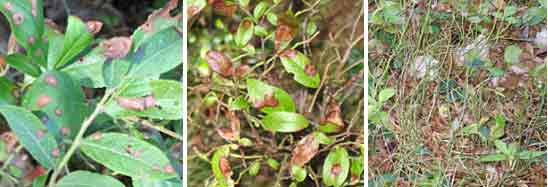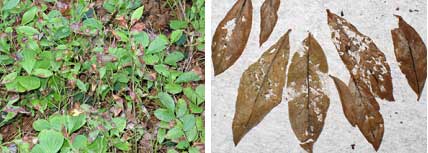Valdensinia Leaf-spot Disease
Prepared by Dr. Seanna Annis, Blueberry Pathologist, School of Biology and Ecology and Dr. David Yarborough, Extension Blueberry Specialist, University of Maine, Orono, ME, USA with information provided by Dr. Paul Hildebrand, Plant Pathologist, Atlantic Food and Horticulture Research Centre, Agriculture and Agri-Food Canada.
Valdensinia leaf spot, NEW Disease in Maine Blueberry Fields

Valdensinia leaf spot (caused by Valdensinia heterodoxa) causes early leaf drop in lowbush blueberries and in pruned fields can cause complete leaf drop so that no flower buds are produced by infected stems. By June 2009, Valdensinia leaf spot had caused complete defoliation in approximately 40 crop and prune fields in Nova Scotia and had been found in Quebec and New Brunswick fields. By July 15, 2009, this fungus had been found in Maine wild blueberry fields and garden plantings.
Valdensinia infects all clones of lowbush blueberry and both prune and crop plants. The spots are typically round, large, and brown, and can have a “bull’s eye” appearance. Leaves can have from one to about ten spots that can be from ⅛ to ½ inch and larger. These spots rapidly enlarge on the leaves and can spread from stem to stem within a few days. This leaf spot causes early leaf drop, and young leaves drop off when infected by only one spot and while still green. Stems can have complete leaf drop or only have a few infected leaves at the top of the stem. Older infected leaves will remain on the plant until leaf drop in the fall. In prune fields, stems with complete leaf drop will not produce flower buds for the next year. Crop fields with leaf drop will have decreased yields and smaller berries. The fallen infected leaves are the source of new spores to cause more infections. The spores are large and very efficient at infecting blueberry leaves. The spores can be produced in 2 days on wet, dead infected leaves on the ground. Mature spores are shot off, up to eight inches high, and typically land on the underside of leaves. The spores will attack all ages of blueberry leaves and will also try to infect all plants they land on so you may see small spots on nearby weeds. The fungus requires about 6 to 8 hours of wet weather (rain or fog) for the spores to infect new leaves. The disease will rapidly spread out from infected stems to adjacent plants as long as the leaf litter remains wet and there is occasionally wet weather for six to eight hours. This fungus produces large, heavy spores that are not carried by the wind so this fungus cannot move across large bare areas or roads without human help.

The fungus survives over the winter in infected leaves. In the spring, about the time of early bloom, it will produce new spores and then leaf infections during the first period of three days of wet weather.
Precautions for ALL Blueberry Fields
- Steam clean all equipment and vehicles before moving them between fields.
- Clean blueberry boxes BEFORE they go into your field. Remove all dead leaves stuck to the boxes in a place away from your field and burn the leaf litter.
Key features to identify this disease:
- Large round spots, 1/8 to 1/2 inch and larger, often look ringed like a bull’s eye on leaves. Typically there are less than ten spots per leaf, often only one to four.
- Stems with leaf drop, particularly of lower leaves. Early in the season, young leaves will fall off while still green.
If you find this disease in your field:
- Do not enter the field when it is wet. Remove dead leaves from your footwear before leaving the diseased area (so you do not spread it around the field).
- Flag off the infected area so no one walks through it or moves equipment through it.
- Check your vehicles or other equipment that may have come in contact with the infected area for dead leaves. Steam clean all equipment and vehicles before moving them between fields.
- Contact Seanna Annis or Dave Yarborough to confirm and report disease (Blueberry Hotline: 1.800.897.0757).
- Follow treatment recommendations below once the disease is confirmed.
Treatment of Infected Fields
Be careful to NOT move dead infected leaves around the field or between fields even after treatment.
- For Prune Fields: As soon as the presence of the disease is confirmed, BURN the diseased area and a 10 ft. area outside the edge of the infected stems with a hand-held burner or by placing straw on the infected area. Burn around edges of the area first, and then move into the center of the diseased area. You do not need to burn your whole field unless your whole field is affected by the disease. The diseased stems produce few if any, flower buds for the crop year and burning will help prevent the spread of this disease to other areas in the field.
- For Crop Fields: Do NOT harvest areas with disease and do NOT move any equipment through the diseased area. As soon as the presence of the disease is confirmed, BURN the diseased area and a 10 ft area outside the edge of the infected stems with a hand-held burner or by placing straw on the infected area. Burn around edges of the area first, and then move into the center of the diseased area. You do not need to burn your whole field unless your whole field is affected by the disease.
- In the Spring of Next Year: From early bloom on, check plants in infected field, particularly in the infected area, for leaf spots after the first period of three days of wet weather. If you see any leaf spots, apply the fungicide that will be recommended in the 2010 Disease Control Guide for Wild Blueberries as soon as possible and before the next wet period.
Information in this publication is provided purely for educational purposes. No responsibility is assumed for any problems associated with the use of products or services mentioned. No endorsement of products or companies is intended, nor is criticism of unnamed products or companies implied.
© 2009
Call 800.287.0274 (in Maine), or 207.581.3188, for information on publications and program offerings from University of Maine Cooperative Extension, or visit extension.umaine.edu.
The University of Maine is an EEO/AA employer, and does not discriminate on the grounds of race, color, religion, sex, sexual orientation, transgender status, gender expression, national origin, citizenship status, age, disability, genetic information or veteran’s status in employment, education, and all other programs and activities. The following person has been designated to handle inquiries regarding non-discrimination policies: Director of Equal Opportunity, 101 Boudreau Hall, University of Maine, Orono, ME 04469-5754, 207.581.1226, TTY 711 (Maine Relay System).
